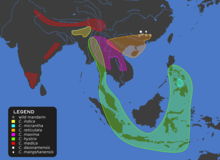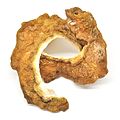Kaffir lime
| Kaffir lime | |
|---|---|

| |
| Fruit on tree | |
| Scientific classification | |
| Kingdom: | Plantae |
| Clade: | Tracheophytes |
| Clade: | Angiosperms |
| Clade: | Eudicots |
| Clade: | Rosids |
| Order: | Sapindales |
| Family: | Rutaceae |
| Genus: | Citrus |
| Species: | C. hystrix
|
| Binomial name | |
| Citrus hystrix | |

| |
| Map of inferred original wild ranges of the main Citrus cultivars, with C. hystrix in pale green[2] | |
| Synonyms[3] | |
| |
Citrus hystrix, called the kaffir lime, Thai lime
Its fruit and leaves are used in
Names
"Kaffir" is thought to ultimately derive from the
The most likely etymology is through the Kaffirs, an ethnic group in Sri Lanka partly descended from enslaved Bantu.[10] The earliest known reference, under the alternative spelling "caffre" is in the 1888 book The Cultivated Oranges, Lemons Etc. of India and Ceylon by Emanuel Bonavia, who notes, "The plantation coolies also smear it over their feet and legs, to keep off land leeches; and therefore in Ceylon [Sri Lanka] it has also got the name of Kudalu dchi, or Leech Lime. Europeans call it Caffre Lime."[10][11] Similarly, H.F. MacMillan's 1910 book A Handbook of Tropical Gardening and Planting notes, "The 'Kaffir Lime' in Ceylon."[10][12]
Another proposed etymology is directly by Indian Muslims of the imported fruit from the non-Muslim lands to the east to "convey otherness and exotic provenance."[10] Claims that the name of the fruit derives directly from the South African ethnic slur "kaffir" (see "South Africa" below) are not well supported.[10]
C. hystrix is known by various names in its native areas:
- jêruk purut in
- jiàn yè chéng (箭叶橙 "arrow-leaf lime") in Chinese.
- kabuyaw or kulubot in the Philippines.[15] The city of Cabuyao in Laguna is named after the fruit.[15]
- Kolumichai, கொலுமிச்சை in Kongu Tamil[16]
- makrud or makrut (มะกรูด, /máʔ.krùːt/) in Thailand (a name also used for the bergamot orange).
- mak khi hut (ໝາກຂີ້ຫູດ, /ma᷆ːk.kʰi᷆ː.hu᷆ːt/) in Laos.
- trúc or chanh sác in Vietnam.[7][17]
- combava in Réunion Island
The
South Africa
In South Africa, the Arabic kafir was adopted by White colonialists as "kaffir,"[10] an ethnic slur for black African people.[19] Consequently, some authors favour switching from "kaffir lime" to "makrut lime," a less well-known name, while in South Africa, it is usually referred to as "Thai lime".[20][21][22]
Description
C. hystrix is a thorny shrub or small tree, 2 to 11 metres (6 to 35 ft) tall, with aromatic and
History
Pierre Sonnerat (1748–1814) collected specimens of it in 1771-72, and it appears in Lamarck's Encyclopédie Méthodique (1796).[26][27]
Makrut lime appears in texts under the name of kaffir lime in 1868, in Ceylon, where rubbing the juice onto legs and socks prevents leech bites.[28] This could be a possible origin of the name leech lime.
Uses
Culinary
C. hystrix leaves are used in Southeast Asian cuisines such as
The rind (peel) is commonly used in Lao and Thai curry paste, adding an aromatic, astringent flavor.[29] The zest of the fruit, referred to as combava,[citation needed] is used in creole cuisine to impart flavor in infused rums and rougails in Mauritius, Réunion, and Madagascar.[34] In Cambodia, the entire fruit is crystallized/candied for eating.[35]
Medicinal
The juice and rinds of the peel are used in traditional medicine in some Asian countries; the fruit's juice is often used in shampoo and is believed to kill head lice.[24]
Other uses
The juice is used as a cleanser for clothing and hair in Thailand
Makrut lime oil is used as raw material in many fields, including pharmaceutical, agronomic, food, sanitary, cosmetic, and perfume industries. It is also used extensively in aromatherapy and as an essential ingredient in various cosmetic and beauty products.[36]
-
Striped snakehead fish stuffed with C. hystrix and lemongrass in preparation for steaming
-
C. hystrix leaves floating in tom yum
-
Fruit longitudinal section
-
Dried fruit rinds
-
Powdered fruit rind, used in Malagasy cuisine
-
Cut leaf strips on chicken phanaeng
-
C. hystrix leaves for sale in Phou Puy Wholesale Vegetable Market in Battambang, Cambodia (August 2022)
Cultivation

C. hystrix is grown worldwide in suitable climates as a garden shrub for home fruit production. It is well suited to
, and in conservatories.Main constituents
The compound responsible for the characteristic aroma was identified as (–)-(S)-citronellal, which is contained in the leaf oil up to 80 percent; minor components include citronellol (10 percent), nerol and limonene.
From a stereochemical point of view, it is remarkable that makrut lime leaves contain only the (S)
Makrut lime fruit peel contains an essential oil comparable to lime fruit peel oil; its main components are limonene and β-pinene.[9][37]
Toxicity
C. hystrix contains significant quantities of
See also
- Citrus taxonomy – Botanical classification of the genus Citrus
References
- ^ "TPL, treatment of Citrus hystrix DC". The Plant List; Version 1. (published on the internet). Royal Botanic Gardens, Kew and the Missouri Botanical Garden. 2010. Retrieved March 9, 2013.
- ISBN 9782918887775.
- ^ The Plant List: A Working List of All Plant Species, retrieved 3 October 2015
- ^ a b "Citrus hystrix - Plant Finder". www.missouribotanicalgarden.org. Retrieved 2024-04-19.
- ^ "Citrus hystrix". Germplasm Resources Information Network. Agricultural Research Service, United States Department of Agriculture. Retrieved December 7, 2014.
- ^ a b "Citrus hystrix". Flora & Fauna Web. National Parks Singapore, Singapore Government. Retrieved 13 August 2018.[dead link]
- ^ "Citrus hystrix". Plant Finder. Missouri Botanical Garden. Retrieved 13 August 2018.
- ^ a b Ng, D.S.H.; Rose, L.C.; Suhaimi, H.; Mohamad, H.; Rozaini, M.Z.H.; Taib, M. (2011). "Preliminary evaluation on the antibacterial activities of Citrus hystrix oil emulsions stabilized by TWEEN 80 and SPAN 80" (PDF). International Journal of Pharmacy and Pharmaceutical Sciences. 3 (Suppl. 2). Archived from the original (PDF) on 2018-04-12. Retrieved 2014-12-10.
- ^ a b c d e f Anderson, L. V. (3 July 2014). "Is the Name Kaffir Lime Racist? Why You May Want to Think Twice About Using That Term". Slate Magazine. Retrieved 1 May 2021.
- ^ Macmillan, Hugh Fraser (1910). A handbook of tropical gardening and planting with special reference to Ceylon. Colombo, Ceylon: H. W. Cave & Co. p. 157.
- ^ Wilkinson, Richard James (1932). "purut". A Malay-English dictionary (romanised). Vol. II. Mytilene: Salavopoulos & Kinderlis. p. 291 – via TROVE.
- ^ pann (2019-04-07). "Apa itu purut?". Glosarium Online (in Indonesian). Retrieved 2020-09-02.
- ^ ISBN 9781439895702.
- ^ "Citrus hystrix DC. | Species". India Biodiversity Portal. Retrieved 2021-12-07.
- ^ Katzer, Gernot. "Kaffir Lime (Citrus hystrix DC.)". Gernot Katzer's Spice Pages. Retrieved 13 August 2018.
- S2CID 242819146.
- ^ Vinje, Veronica (2014-06-23). "Saying "kaffir lime" is like saying the N-word before "lime"". The Georgia Straight. Retrieved 2023-02-07.
- ^ McKenna, Maryn (2014-07-18), "A Food Has a Historic, Objectionable Name. Should We Change It?", National Geographic, archived from the original on 2015-11-18, retrieved 12 December 2015
- ^ Common lime name has racist history by Khalil Akhtar, CBC News, Jul 8, 2014
- American Heritage Dictionary. Retrieved 18 September 2017.
- ISBN 978-81-7993-155-4.
- ^ ISBN 978-0-8248-2094-7.
- ^ jian ye cheng. "Citrix hystrix in Flora of China". Retrieved 11 February 2023.
- ^ D. J. MABBERLEY (2002). "Limau Hantu and Limau Purut. the Story of Lime-Leaves (Citrus hystrix DC, Rutaceae)?" (PDF). Gardens' Bulletin Singapore. 54: 185–197. Retrieved 12 March 2022.
- ^ Bonavia, Emanuel (1888–90). The cultivated oranges and lemons, etc. of India and Ceylon, with researches into their origin and the derivation of their names, and other useful information. With an atlas of illustrations. London: W. H. Allen. p. 309. Retrieved 31 May 2021.
- ^ Henderson, John (capt. 78th Highlanders.) (1868). Skeet, Ch. J. (ed.). The History of the Rebellion in Ceylon During Lord Torrington's Government: Affording a Comparison with Jamaica and Governor Eyre. University of Minnesota. p. 58. Retrieved 31 May 2021.
{{cite book}}: CS1 maint: numeric names: authors list (link) - ^ a b Loha-unchit, Kasma. "Kaffir Lime –Magrood". Retrieved December 7, 2014.
- ^ a b Sukphisit, Suthon (12 November 2017). "Clean up in kitchen with versatile fruit". Bangkok Post. Retrieved 13 November 2017.
- ^ "What to Replace Kaffir Lime Leaves With". Village Bakery. 2018-12-17. Retrieved 2018-12-19.
- ^ "How Mountains Of Worm Cocoons Are Turned Into Expensive Silk In Vietnam | Big Business". YouTube.
- ISBN 978-0-7946-0190-4.
- ^ "Mauritian rum has a distinct character to it: Sweeter and smoother". The Economic Times. 2015-03-22.
- ^ Dy Phon Pauline, 2000, Plants Used In Cambodia, printed by Imprimerie Olympic, Phnom Penh
- S2CID 226314486.
- ^ Kasuan, Nurhani (2013). "Extraction of Citrus hystrix D.C. (Kaffir Lime) Essential Oil Using Automated Steam Distillation Process: Analysis of Volatile Compounds" (PDF). Malaysian Journal of Analytical Sciences. 17 (3): 359–369.
- PMID 26558757.
- S2CID 221810453. Retrieved November 29, 2018.
- S2CID 45603195.







